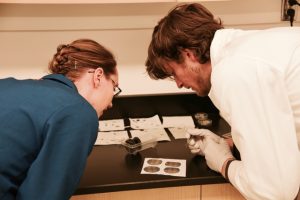‘…there are so many questions to explore and vast possibilities for new ideas. At the same time, research in this field can have immediate societal impact.’
You have had a pretty straight line through your educational career, with three degrees in mechanical engineering. Why did you choose mechanical engineering for your studies?

Mechanical engineers work on solving some of the world’s most pressing problems in energy, environment, transportation, and human health. Becoming a mechanical engineer appealed to me because of opportunities to address these problems head-on.
It’s interesting to think about the specific kinds of sustainability and global change problems that mechanical engineers work on. Where does your research specifically focus?
Our research focus in the Advanced Energy Innovations Lab (AEIL) is designing and developing new materials and devices for electrochemical energy storage technologies. Energy storage is paramount to achieving a sustainable energy future, including integration of intermittent renewable energy sources and supporting rapidly growing markets in electric vehicles and consumer electronics. Our goal is to improve the energy storage capabilities of electrochemical energy storage technologies (including batteries and supercapacitors), while also reducing their overall life-cycle environmental impacts.
The mission of your lab, the AEIL, is to “pioneer new technologies that will improve the energy future of society”. What kinds of new materials and designs are you working on right now?
Our current focus is studying new materials for supercapacitor energy storage. In one project, we’re developing new conducting polymer-based supercapacitor electrodes that have good energy storage properties, but are also biodegradable and biocompatible. We’re also working on understanding fundamental charge storage mechanisms in energy storage materials by designing supercapacitor electrodes that can be used for in-situ NMR/MRI studies, and by developing advanced simulation capabilities.

How would you describe a supercapacitor to the layperson who wants to better understand what your lab does?
An electrochemical capacitor, or “supercapacitor”, is an energy storage device that uses surface reactions to store electrochemical energy, as opposed to bulk chemical reactions in a battery. This surface-charging mechanism gives supercapacitors high power density and high cycle lifetimes compared to batteries (supercapacitors can charge and discharge in seconds, and sustain over a million recharge cycles). As a result, supercapacitors have many promising applications in consumer electronics, renewable energy storage, electric vehicles, and energy recovery.
The AEIL website mentions a goal to reduce the life-cycle environmental impacts of supercapacitors. What are some of those impacts?
As with any device or material, it’s important to consider potential environmental impacts over the entire lifecycle of energy storage devices. This includes energy and materials associated with manufacturing, and options for disposal at end-of-life. Many electrochemical energy storage devices require high temperatures and harsh chemicals for synthesis. This is an area that can be improved. Another important consideration is choosing materials that have good end-of-life options. In our research on biodegradable energy storage materials, we’re studying supercapacitor electrode materials that can dissolve in mild aqueous conditions after use.
The work you do has so many different kinds of applications and potential. What drew you to this vein of research?
I love posing questions, designing experiments to test these questions, and being surprised by the answers! In the field of electrochemical energy storage, there are so many questions to explore and vast possibilities for new ideas. At the same time, research in this field can have immediate societal impact.

Has participating with the GCSC been helpful for your work? If so, how?
As a faculty affiliate of the GCSC, I’ve been inspired by new ideas at faculty think-tank events and the GCSC fall retreat. Being part of the GCSC also provides great opportunities for my students to present their work at the annual GCSC Research Symposium. In addition, my student Virginia Diaz received a GCSC travel grant to present her research on biodegradable energy storage materials at The Electrochemical Society meeting in New Orleans this spring.
What about the center inspired you to become a faculty affiliate?
Getting to meet faculty and students from other departments and fields working on sustainability is really inspiring. The GCSC is a wonderful community for building interdisciplinary connections, and broadening one’s perspective on energy, the environment, and sustainability.
